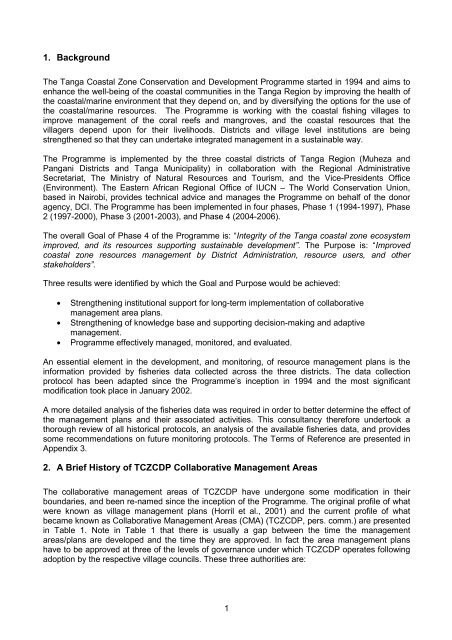Create successful ePaper yourself
Turn your PDF publications into a flip-book with our unique Google optimized e-Paper software.
1. Background<br />
The <strong>Tanga</strong> Coastal Zone Conservation and Development Programme started in 1994 and aims to<br />
enhance the well-being of the coastal communities in the <strong>Tanga</strong> Region by improving the health of<br />
the coastal/marine environment that they depend on, and by diversifying the options for the use of<br />
the coastal/marine resources. The Programme is working with the coastal fishing villages to<br />
improve management of the coral reefs and mangroves, and the coastal resources that the<br />
villagers depend upon for their livelihoods. Districts and village level institutions are being<br />
strengthened so that they can undertake integrated management in a sustainable way.<br />
The Programme is implemented by the three coastal districts of <strong>Tanga</strong> Region (Muheza and<br />
Pangani Districts and <strong>Tanga</strong> Municipality) in collaboration with the Regional Administrative<br />
Secretariat, The Ministry of Natural Resources and Tourism, and the Vice-Presidents Office<br />
(Environment). The Eastern African Regional Office of <strong>IUCN</strong> – The World Conservation Union,<br />
based in Nairobi, provides technical advice and manages the Programme on behalf of the donor<br />
agency, DCI. The Programme has been implemented in four phases, Phase 1 (1994-1997), Phase<br />
2 (1997-2000), Phase 3 (2001-2003), and Phase 4 (2004-2006).<br />
The overall Goal of Phase 4 of the Programme is: “Integrity of the <strong>Tanga</strong> coastal zone ecosystem<br />
improved, and its resources supporting sustainable development”. The Purpose is: “Improved<br />
coastal zone resources management by District Administration, resource users, and other<br />
stakeholders”.<br />
Three results were identified by which the Goal and Purpose would be achieved:<br />
• Strengthening institutional support for long-term implementation of collaborative<br />
management area plans.<br />
• Strengthening of knowledge base and supporting decision-making and adaptive<br />
management.<br />
• Programme effectively managed, monitored, and evaluated.<br />
An essential element in the development, and monitoring, of resource management plans is the<br />
information provided by fisheries data collected across the three districts. The data collection<br />
protocol has been adapted since the Programme’s inception in 1994 and the most significant<br />
modification took place in January 2002.<br />
A more detailed analysis of the fisheries data was required in order to better determine the effect of<br />
the management plans and their associated activities. This consultancy therefore undertook a<br />
thorough review of all historical protocols, an analysis of the available fisheries data, and provides<br />
some recommendations on future monitoring protocols. The Terms of Reference are presented in<br />
Appendix 3.<br />
2. A Brief History of TCZCDP Collaborative Management Areas<br />
The collaborative management areas of TCZCDP have undergone some modification in their<br />
boundaries, and been re-named since the inception of the Programme. The original profile of what<br />
were known as village management plans (Horril et al., 2001) and the current profile of what<br />
became known as Collaborative Management Areas (CMA) (TCZCDP, pers. comm.) are presented<br />
in Table 1. Note in Table 1 that there is usually a gap between the time the management<br />
areas/plans are developed and the time they are approved. In fact the area management plans<br />
have to be approved at three of the levels of governance under which TCZCDP operates following<br />
adoption by the respective village councils. These three authorities are:<br />
1
















